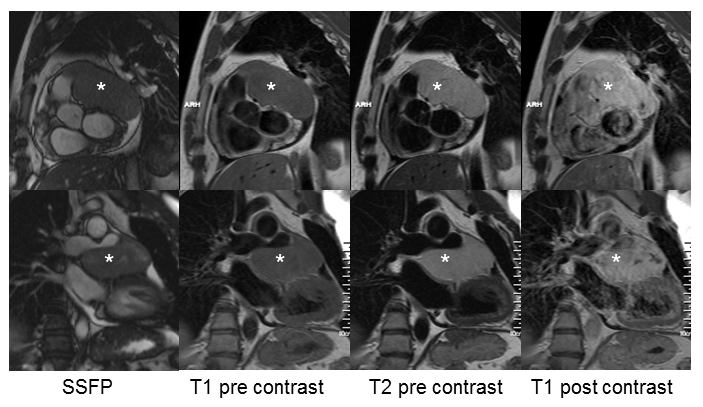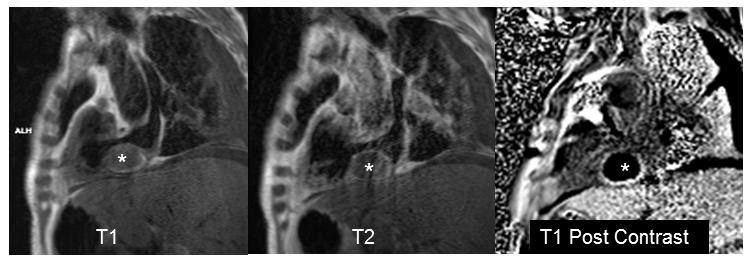CMR and Pericardial Masses
Introduction
Cardiac masses are characterized as either primary or secondary tumors. Primary cardiac tumors are rare, with a 0.001% to 0.03% incidence found in autopsies while secondary tumors have an incidence of 1.7% to 14%.1 Pericardial tumors are even less common with primary pericardial tumors accounting for only 6.7%- 12.8% of all primary cardiac tumors.2,3 Clinical diagnosis of pericardial masses is very difficult since patients may present with diverse, nonspecific symptoms depending on whether there is associated pericardial effusion, pericarditis, or invasion of adjacent structures with resultant hemodynamic effects. Thus, imaging plays an important role in the evaluation of such patients. Although the diagnostic workup often starts with chest roentgenography or transthoracic echocardiography, further investigation is often warranted in order to visualize the entire pericardium and more specifically characterize the lesions in question.
Cardiovascular Magnetic Resonance
Cardiac magnetic resonance (CMR) is currently the ideal diagnostic imaging test for assessment of the pericardium and pericardial masses. The normal pericardium appears as a less than 2mm dark band sandwiched between the bright epicardial and mediastinal fat layers.4,5 CMR has been shown to improve detection of cardiac masses, particularly paracardiac masses, which may not be well visualized on routine transthoracic echocardiography (TTE).6,7 Studies have demonstrated that 10-20% of cardiac tumors detected by CMR are missed on routine TTE,6,7 with most of them located in the pericardium or adjacent mediastinum.6 CMR provides multiplanar imaging with a wide field of view, high spatial and temporal resolutions, and high intrinsic soft tissue contrast without need for ionizing radiation or iodinated contrast. Specific sequences allow for different tissue weightings and intravenous contrast can be applied for further insight into the internal composition of the mass8 (Table 1). Both still and cine images are often acquired to further characterize pericardial masses and evaluate for pericardial effusion, myocardial invasion, myocardial infarction, involvement of coronary arteries and secondary functional and hemodynamic effects on the heart such as compression, diastolic dysfunction and/or constrictive physiology. CMR also provides additional information on resectability of masses as well as associated complications such as invasion of mediastinal structures, regional or distant metastases, and encasement of vital structures.
Table 1: MRI Sequences Used to Evaluate the Pericardium
Sequence |
Suggested Planes |
Information |
Scouts |
Axial, sagittal, coronal |
Localizing |
HASTE FSE/TSE |
Axial, sagittal, coronal |
Define anatomy and plan subsequent views |
Cine SSFP |
Long axis, short axis |
Evaluate function, volumes, presence of masses |
Myocardial tagging |
Long axis, short axis, targeted views of mass |
Evaluate pericardial movement and assess for local invasion of the mass |
T1 and T2 FSE/TSE |
Long axis, short axis, targeted views of mass |
Assess pericardial morphology and tissue characteristics of mass |
T2 FSE/TSE STIR |
Long axis, short axis, targeted views of mass |
Evaluate for pericardial edema due to inflammation and tissue characteristics of mass |
Early contrast-enhanced T1-weighted FSE/TSE |
Long axis, short axis, targeted views of mass |
Evaluate for inflammation and tissue characteristics of mass |
Delayed enhancement |
Long axis, short axis, targeted views of mass |
Evaluate for pericardial and myocardial inflammation and fibrosis, and tissue characteristics of mass |
Real-time imaging |
Short axis |
Evaluate for ventricular interdependence |
Velocity-encoded phase-contrast |
Aorta, PA, systemic and pulmonary veins |
Assess vascular flow patterns for possible secondary hemodynamic effects of mass |
Pericardial Masses
Masses of the heart and pericardium are classified as neoplastic, both primary and secondary, non-neoplastic, and non-tumoral. A classification scheme of the most common pericardial masses encountered is shown in Table 2.
Table 2: Pericardial Masses
Neoplastic |
|
|
||
Primary |
Secondary |
Non-neoplastic |
Other |
|
Benign |
Malignant |
Metastatic |
Cyst* |
Hematoma |
Lipoma* |
Mesothelioma* |
Breast* |
Pericardial diverticulum |
Thrombus |
Hemangioma |
Sarcoma |
Lung |
Inflammatory pseudotumor |
Loculated fluid |
Fibroma |
Lymphoma |
Renal cell carcinoma |
|
Pseudoaneurysm |
Angioma |
Lymphoma |
|||
Teratoma |
Malignant teratoma |
Melanoma |
|
Enlarged lymph nodes |
Paraganglioma |
Hemangioendothelioma |
Thymoma |
|
Gossypiboma |
Lymphangioma |
Neuroectodermal tumor |
Mediastinal tumor |
|
|
Neurofibroma |
|
Multiple myeloma |
|
|
Lipoblastoma |
|
Esophagus |
|
|
Granular cell |
|
Leukemia |
|
|
The most common primary pericardial masses are benign pericardial cysts. These fluid- containing structures are thought to be formed from sections of the pericardium that pinch off during embryonic development.8 Although they can occur anywhere along the pericardium, they are most commonly seen in the right cardiophrenic angle.8,5,9 Pericardial cysts are well-defined, homogenous structures on CMR,6 characterized by low signal intensity on T1 and high signal intensity on T2 images without contrast enhancement.5,9 (Figure 1)
Figure 1: Pericardial Cyst
Primary pericardial tumors are rare and occur much less frequently than secondary pericardial metastasis.9 Primary tumors can be benign, including lipoma, hemangioma, teratoma or malignant, including mesothelioma, sarcoma and lymphoma (Movies 1, 2).10 Metastatic tumors are usually of breast, lung and bone marrow origin.10 CMR can provide information on tumor location, site of insertion as well as relationship to adjacent structures, allowing for evaluation of feasibility for surgical resection.10 (Figure 2) CMR can provide crucial information on the histopathology of cardiac masses,6,9,11 although tissue biopsy is often still required for diagnosis. CMR can accurately detect the high fatty content of lipoma and liposarcomas noted by homogenous high T1 and T2 weighted signal intensity.6,11 Compared to benign tumors, malignant tumors often demonstrate additional features of nonmobility, associated pericardial effusion, and myocardial invasion.6 (Figure 3) The presence of disrupted pericardium, hemorrhagic effusion, invasion into the epicardial fat, myocardium, or cardiac chambers and associated mediastinal or pericardial lymphadenopathy are additional signs of aggressive disease.12
Figure 2: Fibrosarcoma without invasion into myocarium
Figure 3: Cardiac lymphoma with invasion into myocardium
Pericardial hematomas usually form after surgery or trauma,4 and may be accurately assessed by CMR (Movie 3). CMR has been shown to have excellent accuracy in the differentiation of cardiac thrombi or hematoma from tumors.6,9,11 In general, thrombi tend to be smaller, more homogeneous and less mobile compared to tumors9 while tumors often demonstrate increased hyperintensity on T2 weighted images and contrast enhancement.6 The age of the hematoma determines CMR appearances.4,6 During the subacute phase, hematomas appear as a fluid collection with heterogenous intermediate to high signal on T1 and T2 weighted sequences while in the chronic phase, the hematoma displays low signal with a dark rim.4 (Figure 4)
Figure 4: Pericardial hematoma
Conclusion
CMR is a useful imaging tool to evaluate the pericardium and diagnose pericardial masses. With the use of various imaging sequences and wide field of views, CMR can noninvasively provide information on the cardiac structure, morphology, function and associated complications that are important to the diagnosis and management of a variety of pericardial masses.
Movie 1 – Lymphoma
Movie 2 – Fibrosarcoma
Movie 3 – Hematoma
References
- Mann, D. L., Zipes, D. P., Libby, P., Bonow, R. O. & Braunwald, E. Braunwald's Heart Disease. (Elsevier Saunders, 2015).
- Meng, Q. et al. Echocardiographic and pathologic characteristics of primary cardiac tumors: a study of 149 cases. Int. J. Cardiol. 84, 69–75 (2016).
- Patel, J. & Sheppard, M. N. Pathological study of primary cardiac and pericardial tumours in a specialist UK Centre: surgical and autopsy series. Cardiovasc. Pathol. 19, 343–352 (2016).
- Axel, L. Assessment of pericardial disease by magnetic resonance and computed tomography. J. Magn. Reson. Imaging 19, 816–826 (2004).
- Rajiah, P. Cardiac MRI: Part 2, pericardial diseases. Am. J. Roentgenol. 197, (2011).
- Patel, R. et al. Diagnostic Performance of Cardiac Magnetic Resonance Imaging and Echocardiography in Evaluation of Cardiac and Paracardiac Masses. Am. J. Cardiol. 117, 135–140 (2016).
- Staab, W. et al. Detection of intracardiac masses in patients with coronary artery disease using cardiac magnetic resonance imaging: a comparison with transthoracic echocardiography. Int. J. Cardiovasc. Imaging 647–657 (2014). doi:10.1007/s10554-013-0357-9
- Grizzard, J. D. Magnetic Resonance Imaging of Pericardial Disease and Intracardiac Thrombus. Heart Fail. Clin. 5, 401–419 (2009).
- Pazos-Lopez, P. et al. Value of CMR for the differential diagnosis of cardiac masses. JACC Cardiovasc. Imaging 7, 896–905 (2014).
- Bogaert, J. & Francone, M. Cardiovascular magnetic resonance in pericardial diseases. J. Cardiovasc. Magn. Reson. 11, 14 (2009).
- Hong, Y. J. et al. The usefulness of delayed contrast-enhanced cardiovascular magnetic resonance imaging in differentiating cardiac tumors from thrombi in stroke patients. Int. J. Cardiovasc. Imaging 1–7 (2011). doi:10.1007/s10554-011-9961-8
- Verhaert, D. et al. The role of multimodality imaging in the management of pericardial disease. Circ. Cardiovasc. Imaging 3, 333–343 (2010).
Keywords: Aneurysm, False, Aorta, Aortic Aneurysm, Bone Marrow, Breast Neoplasms, Carcinoma, Renal Cell, Coronary Vessels, Diverticulum, Echocardiography, Edema, Esophagus, Fibroma, Fibrosarcoma, Granuloma, Plasma Cell, Heart Atria, Heart Neoplasms, Hemangioendothelioma, Hemangioma, Hemodynamics, Inflammation, Leukemia, Lipoblastoma, Liposarcoma, Lymph Nodes, Lymphangioma, Lymphoma, Magnetic Resonance Spectroscopy, Mediastinal Cyst, Mediastinum, Mesothelioma, Multiple Myeloma, Myocardial Infarction, Myocardium, Neoplasms, Muscle Tissue, Neuroectodermal Tumors, Neurofibroma, Paraganglioma, Pericardial Effusion, Pericarditis, Pericardium, Pulmonary Artery, Pulmonary Veins, Sagittaria, Sarcoma, Teratoma, Thrombosis, Thymoma, Tricuspid Valve, Gamma Rays
< Back to Listings




